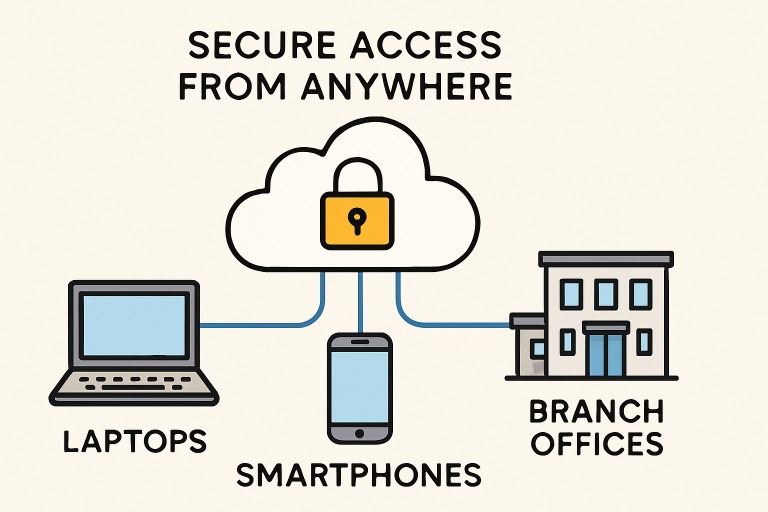Table of Contents
- Introduction
- Understanding SASE
- Key Components of SASE
- Benefits of Adopting SASE
- Implementing SASE in Enterprise Networks
- Real-World Examples of SASE Adoption
- Challenges and Considerations
- Future Trends in SASE
- Conclusion
In an era where remote work, digital transformation, and cloud-first strategies disrupt traditional network models, organizations need secure, flexible, and scalable connectivity like never before. One solution at the forefront of this evolution is SASE (Secure Access Service Edge). SASE is a cloud-based framework that combines networking and security to meet the needs of modern enterprises. It offers secure access to applications and data from anywhere and on any device, making it an industry standard. SASE is gaining traction as businesses prioritize digital agility and resilience. It enables organizations to reduce latency, minimize risk, and leverage the cloud to its fullest potential. Surveys show that nearly every sector considers SASE as organizations transition to remote and hybrid workplaces. Adoption is expected to increase further as IT leaders recognize the advantages of simplified management and reduced operational overhead.
Understanding SASE
SASE (pronounced “sassy”) consolidates networking and security capabilities by delivering them as a single cloud-based service. This model replaces the fragmented, perimeter-based security approach of the past with dynamic, edge-delivered protection. SASE fundamentally addresses the issues of network performance, security effectiveness, and the growing necessity for remote access as enterprises migrate resources and workflows to the cloud. This framework provides secure connectivity regardless of where users or devices are located. By moving security and access controls out of the data center and closer to the end user the “edge” SASE solutions ensure consistent policy application and strong threat protection, whether employees are in headquarters, branch offices, or remote locations. A recent overview in CSO Online underscores SASE’s capacity to close gaps left by traditional architectures through this comprehensive integration.
Key Components of SASE
- Software-Defined Wide Area Network (SD-WAN): SASE utilizes SD-WAN to manage and route network traffic efficiently, improving performance for cloud-based and on-premises applications alike.
- Secure Web Gateway (SWG): SWGs analyze and filter traffic destined for the web, preventing malicious code and suspicious activity before they reach users or resources.
- Cloud Access Security Broker (CASB): CASBs enforce security policies, provide visibility into cloud application usage, and identify risky behavior and shadow IT.
- Firewall as a Service (FWaaS): FWaaS delivers full enterprise firewall functionality from the cloud, safeguarding against threats without needing physical hardware appliances.
- Zero Trust Network Access (ZTNA): ZTNA restricts user access based on strict identity verification, supporting least privilege principles and significantly reducing the attack surface.
Benefits of Adopting SASE
- Enhanced Security: By combining multiple security services—including web filtering, data loss prevention, and threat intelligence—into one platform, SASE streamlines protection and reduces complexity. Organizations benefit from consistent policies, regardless of user location.
- Improved Performance: Direct-to-cloud connectivity reduces data backhauling, significantly reducing latency. Users experience smoother, faster access to applications and information.
- Scalability: SASE’s cloud-native design allows IT teams to expand or contract coverage as needed. New branches, remote users, or workloads can be securely connected in a fraction of the time legacy systems require.
- Cost Efficiency: SASE’s converged model reduces capital and operational expenses by consolidating vendors and minimizing the need for on-site hardware and costly maintenance.
Implementing SASE in Enterprise Networks
- Assessment: Begin by conducting a thorough audit of the current network and security infrastructure, user requirements, and business objectives to identify security coverage gaps and workflow bottlenecks.
- Planning: Develop a phased adoption roadmap. Consider the specific locations, users, and apps that will most benefit from SASE’s integrated services.
- Deployment: Start with pilot projects, deploying SASE solutions where they’ll have the most significant impact. Expansion should be methodical, ensuring business continuity during the transition.
- Monitoring: Continuously monitor network health and policy enforcement, adapting configurations based on threat intelligence and business needs to ensure optimal protection and reliability.
Real-World Examples of SASE Adoption
Organizations across industries, from financial services to manufacturing, have achieved significant gains through SASE adoption. Nearly all surveyed IT executives plan to increase investments in cloud-first, SASE-enabled architectures. This widespread interest highlights SASE’s unmatched ability to provide secure, high-performance connectivity amid evolving threat vectors and distributed workforces. For example, global enterprises have used SASE to enforce unified policies across remote branches, streamline secure access for remote employees, and replace expensive, aging MPLS circuits with flexible SD-WAN combined with strong security all managed from a single cloud platform.
Challenges and Considerations
- Integration Complexity: Integrating SASE with existing network and security infrastructure can present technical and process-related challenges, particularly for large, complex organizations with legacy systems.
- Skill Gaps: SASE adoption may require upskilling IT staff, especially in cloud technology and the orchestration of converged platforms.
- Vendor Selection: SASE providers’ offerings can vary widely. Before making a choice, it’s crucial to assess each provider’s solutions, performance, security features, and global reach.
Future Trends in SASE
The SASE market is projected to grow rapidly, with Gartner estimating a 26% CAGR and reaching $28.5 billion by 2028. Key drivers include increased remote work, a boom in IoT and cloud adoption, and the growing sophistication of cyber attacks. Trends such as AI-driven threat detection and expanded integration with identity and access management technologies are expected further to enhance SASE’s value in the coming years.
Conclusion
SASE is more than just another network technology it’s a paradigm shift that defines the future of enterprise security and networking. As businesses grow more globally distributed and reliant on the cloud, SASE’s unified, cloud-delivered model provides the required agility, protection, and scalability. Adopting SASE today can position organizations to outpace digital risk and complexity, supporting innovation and resilience for years.

